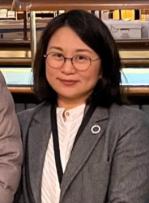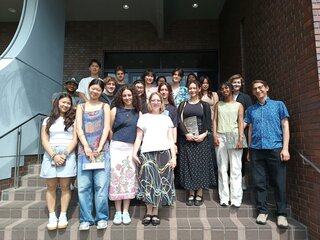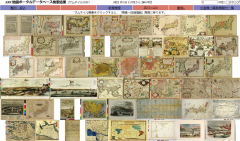-
On May 22, 2025, a group of students from Northeastern University visited the Art Research Center (ARC) as part of the university's study abroad program Dialogue: Shoshin Japan: Art, Craft, and Design in Kyoto. The group was led by Associate Teaching Professors Jamal Thorne and Kate Terrado of the College of Arts, Media, and Design (CAMD) at Northeastern University.
Besides touring the ARC's building and facilities, discussions and an exchange of ideas on collaboration in digital humanities took place with Dr. Travis Seifman (Associate Professor, Kinugasa Research Organization/ARC Research Manager).
 With the establishment of the International Joint Digital Archiving Center for Japanese Art and Culture (ARC-iJAC) in 2019, the Art Research Center strives to push the internationalization of research activities that transcend disciplines and geographic boundaries.
With the establishment of the International Joint Digital Archiving Center for Japanese Art and Culture (ARC-iJAC) in 2019, the Art Research Center strives to push the internationalization of research activities that transcend disciplines and geographic boundaries.NEWS
Spring has arrived at Ritsumeikan University's Kinugasa Campus, where the grounds were for weeks beautifully adorned with cherry blossoms in full bloom.


The release of over 570 illustrated books, ukiyo-e painting manuals, and other early modern Japanese books marks the latest milestone in the collaboration between the Royal Museums of Art and History (MRAH) and the ARC, which began in 2007. Furthermore, 8,750 ukiyo-e prints previously released are also available through the ARC Japanese Prints (Ukiyo-e) and Paintings Portal Database. >> Read more.
MRAH Collection of Illustrated Books:
https://www.dh-jac.net/db1/books/search_belgium.php
MRAH Collection of Ukiyo-e Prints:
https://www.dh-jac.net/db/nishikie/search_belgium.php YOU ARE
YOU ARE
WARMLY INVITED!
To mark Ritsumeikan University's 125th anniversary, the KINUGASA ART VILLAGE FESTIVAL will be held on June 1, at Kinugasa Campus.
The ARC will present a Public Exhibition of the William Sturgis Bigelow Shuten-dōji Picture Scrolls, alongside a Conversation between Dr. Shugo Asano (Director, Abeno Harukas Art Museum) and Prof. Ryo Akama on 'Ukiyo-e and its Global Reach.'
>> Read more.Start of Digital-Archiving the Japanese Collection of
the Museum Five Continents, Munich
In February, Prof. Ryo Akama and his students launched a digital-archiving project of Japanese woodblock prints from the collection of the Museum Five Continents (Museum Fünf Kontinente) in Munich, Germany's first ethnological museum, founded in 1862.
Special thanks to Dr. Uta Werlich (Director of the Museum), Prof. Hans B. Thomsen and Dr. Klaus J. Friese for their generous support.

Dr. Seifman reflects on his role as Research Manager at the ARC, his research on Ryukyuan embassies, as well as the impact of the Center's digital archives and global research collaborations.
>> Read more.
Congratulations to Prof. Koichi Hosoi on receiving this award for his contributions to the arts and talent development in Kyoto. Prof. Hosoi has held key roles at Ritsumeikan University, including Director of the Art Research Center and the Kinugasa Research Organization. >> Read more.  The ARC Japanese Old Maps Portal Database offers access to over 5,000 historical maps, including materials from the ARC and major holdings from other institutions such as the University of California, Berkeley.
The ARC Japanese Old Maps Portal Database offers access to over 5,000 historical maps, including materials from the ARC and major holdings from other institutions such as the University of California, Berkeley.
As part of the latest update, 311 Japanese old maps from the British Library have been added, alongside the introduction pyramid (tiled) display function based on the IIIF standard, allowing for smoother and more detailed map viewing. >> Read more.
ARC Japanese Old Maps Portal Database:
https://www.dh-jac.net/db/maps/search_portal.php
Database of Japanese Old Maps in the British Library Collection
https://www.dh-jac.net/db/maps/search_BL.phpUpcoming Events
May 21 (Wed), 2025, 18:30-20:00 JST
147. International ARC Seminar
Speaker: Dr. Charlotte HORLYCK (Reader in the History of Korean Art/Head of School of Arts, SOAS University of London)
Topic: 'Mining the Archive for Collecting Histories of Korean Art' (held in English)
→ YouTube livestream available
May 28 (Wed), 2025, 18:30-20:00 JST
148. International ARC Seminar
1. Speaker: Dr. Koichi HOSOI (Professor, Department of Social Informatics, ZEN University/Senior Research Fellow, Art Research Center, Ritsumeikan University)
2. Speaker: Yuji MIYATA (Lecturer, History of Content Industry Archives Research Center/ Visiting Researcher, Art Research Center, Ritsumeikan University)
Topic: 'Archiving the History of the Content Industry: Initiatives and Challenges of ZEN University'
→ YouTube livestream available
June 1 (Sun), 2025, 10:00-17:00 JST
KINUGASA ART VILLAGE FESTIVAL
Kinugasa Campus, Ritsumeikan University, KyotoPublic Exhibition
William Sturgis Bigelow Shuten-dōji Picture Scrolls
Venue: Art Research Center (ARC)A Conversation on
「浮世絵の国際性」('Ukiyo-e and its Global Reach')
Dr. Shugo Asano (Director, Abeno Harukas Art Museum/Director, Yamato Bunkakan Museum)
&
Prof. Ryo Akama (Director, Art Research Center/College of Letters, Ritsumeikan University)Free entrance.
→ Read more.
June 11 (Wed), 2025, 18:30-20:00 JST
149. International ARC Seminar
Speaker: Osamu YOSHIDA (President, Tsukiji Sugoroku Museum)
Topic: 'Playing the Sugoroku of the Forest of Knowledge: Fun, Database, and History'
→ YouTube livestream available


view this email in your browser Copyright © 2024 Art Research Center, Ritsumeikan University. All rights reserved.
Our mailing address is:
56-1 Toji-in Kitamachi, Kita-ku, Kyoto 603-8577 JAPAN
Want to change how you receive these emails?
You can update your preferences or unsubscribe from this list.[イベント情報]April 24, 2025(Thu)Background:
Originally from New York, Travis Seifman completed MA degrees in Japanese Studies at SOAS University of London and in Art History at the University of Hawaiʻi at Mānoa before earning his PhD in History at the University of California, Santa Barbara. Before joining the ARC, he worked as a postdoctoral Project Researcher at the University of Tokyo Historiographical Institute, where he contributed to the production of an English-language translation of the Ishin Shiryō Kōyō Database. Travis Seifman specializes in Okinawan Studies, and researches in particular the embassies dispatched by the Okinawan kingdom of Lūchū (Ryūkyū) to Edo in the 17th to 19th centuries. Following the 2019 fire at Sui gusuku (Shuri castle), the former Luchuan royal palace, he began to explore the topic of restoration of the palace in the 1980s-90s and again today, and related issues of cultural heritage.Dr. Seifman, thank you very much for your time today. What are some of the main responsibilities in your current role as a Research Manager at the ARC?
Seifman: My responsibilities are fairly wide-ranging. I help facilitate overseas research collaborations and networks, particularly with individuals and institutions in Europe and North America, acting as one of the main points of contact for our affiliated researchers overseas and working to recruit new research projects and partnerships.

I serve on the Center's Steering Committee as well as the Editorial Committee for the Center's journal, ART RESEARCH. Additionally, I coordinate the International ARC Seminar, our twice-monthly guest lecture series, and assist with a wide range of administrative duties, especially those involving English-language communications.
You first became connected with the ARC during your internship at the Smithsonian. Could you share more about that experience?
Seifman: In the summer of 2011, I spent about ten weeks as a digitization intern at the Freer-Sackler Galleries (now the National Museum of Asian Art), at the Smithsonian Institution, where I had the opportunity to experience the ARC's Digital Archiving Model firsthand. Along with two fellow interns, and under the guidance of Dr. Ryoko Matsuba, we photographed some 2,000 Japanese woodblock-printed and other illustrated books from the 17th to 20th centuries.
Read more>>The 14th Forum for Knowledge, Arts, and Culture in Digital Humanities will be held on Saturday, March 22, 2025.
We are now accepting →registrations to join the event as a participant. This event also serves as a conference for young researchers of the ARC-iJAC.
About the Forum for Knowledge, Arts, and Culture in Digital Humanities
Along with the rapid development of the digital and information environment in recent years, we are seeing more and more cross-disciplinary research in academic fields with an awareness of "information" and "digital". This trend is gaining momentum in higher education and research activities as well, and educational programs and course activities related to this trend are being enhanced.
The need for opportunities for academic exchange among undergraduate and graduate students and young researchers studying in such programs under new research themes in line with the times is ever increasing.
For this reason, the Forum for Knowledge, Arts, and Culture in Digital Humanities was established in 2011 as a place for presentation and exchange, with a focus on graduate students and young researchers interested in information and knowledge research in arts, culture, and other related fields, and 13 research meetings have been held to date.
This meeting is positioned as a place where participants can mutually discover new research themes and methods through human exchange in different fields, and we also welcome exploratory and adventurous presentations that are slightly different from conventional conference presentations.
■ Date: March 22 (Sat), 2025, from 12:30 noon JST
■ Hybrid format
Venue: Future Plaza Conferece Room, Ritsumeikan University Osaka Ibaraki Campus
(https://www.ritsumei.ac.jp/futureplaza/conferencehall/)Online via ZOOM.
■ Program & presentation abstracts: Please click →here (in Japanese).
■ Register as a participant: Please register via →Google Forms. (Deadline: Wednesday, March 19, 2025)
※ There is no participation fee.
※A get-together is planned to be held after the research presentations (face-to-face only). We would like to make it a place for exchange beyond the boundaries of universities and research fields, so please feel free to join us. The venue, participation fee, etc. will be announced shortly.
Organizer: The Forum for Knowledge, Arts, and Culture in Digital Humanities
Facilitators: Ryo Akama (Ritsumeikan University), Mamiko Sakata (Doshisha University), Naoki Takubo (Kindai University), Takehiko Murakawa (Wakayama University), Ryosuke Yamanishi (Kansai University)
Co-organizers: The Kansai Division of the Art Documentation Society and the Kansai Division of the Japan Society of Information and Knowledge
In cooperation with: International Joint Digital Archiving Center for Japanese Art and Culture (ARC-iJAC), Art Research Center, Ritsumeikan University.
Inquiries: kacimeeting+2025■gmail.com (please change "■" to "@")
■ Related links:
The Art Research Center (ARC) at Ritsumeikan University is pleased to announce the full-scale operation of the ARC Japanese Old Maps Portal Database. This database includes not only valuable historical maps from the ARC's collection but also major collections from institutions such as the University of California, Berkeley, with a total of over 5,000 old maps available.
As part of this update, 311 old maps of Japan from the British Library have been added to the database. In conjunction with this, we have introduced a pyramid (tiled) display function based on the IIIF (International Image Interoperability Framework) standard, allowing users to view maps more smoothly.
ARC Japanese Old Maps Portal Database
https://www.dh-jac.net/db/maps/search_portal.phpDatabase of Japanese Old Maps in the British Library Collection
https://www.dh-jac.net/db/maps/search_BL.phpMoving forward, we plan to gradually implement this pyramid display function for old maps already added to this database previously. Furthermore, we will continue to expand the database by incorporating other collections.
To facilitate accessibility and utilization, we will also work towards integrating this database with external platforms such as Japan Search, ensuring that a wider audience can benefit from this resource. This will begin with the British Library maps becoming available on Japan Search by the end of March 2025 (tentative).
We hope you find this database useful for your research.
[イベント情報]February 22, 2025(Sat)Day 1: Friday, February 21, 10:00 -16:50 JST (tentative)
Day 2: Saturday, February 22, 10:00 -17:00 JST (tentative)Hybrid event (ARC & online via Zoom)
Presentations marked with ★ are available via YouTube live stream.
Organised by: International Joint Digital Archiving Center for Japanese Art and Culture (ARC-iJAC) & Digital Humanities Center for Japanese Arts and Cultures "Program for Supporting Research Center Formation", Ritsumeikan University
Click here for the program.
[イベント情報]February 21, 2025(Fri)Day 1: Friday, February 21, 10:00 -16:50 JST (tentative)
Day 2: Saturday, February 22, 10:00 -17:00 JST (tentative)Hybrid event (ARC & online via Zoom)
Presentations marked with ★ are available via YouTube live stream.
Organised by: International Joint Digital Archiving Center for Japanese Art and Culture (ARC-iJAC) & Digital Humanities Center for Japanese Arts and Cultures "Program for Supporting Research Center Formation", Ritsumeikan University
Click here for the program.
[イベント情報]February 19, 2025(Wed)A special session of the International ARC Seminar under the theme of "The online publication of the ARC's Japanese old maps, including the British Library Map Collection" will be held as a webinar on Wednesday, February 19, 18:00-20:00 JST.
About this seminar:
Since the 2000s, historical GIS, which combines historical geography and geographic information science, has been rapidly developing in Japan and around the world as part of digital humanities. However, most of the geospatial data in Japan, such as modern maps and ledgers, has not been digitized and is not available in GIS format. In order to develop historical GIS, it is essential to digitize paper-based geospatial data, convert it to GIS format, and make it publicly available. Furthermore, in order to make it available to people who are not GIS experts, such as museum curators and educators, it is necessary to provide an easy-to-use framework for online searching and GIS analysis.This seminar will introduce the development of 1) the 'ARC Map Portal Database', which is a platform for old Japanese maps, 2) the Japanese version of "Map Warper," and 3) "Old Japanese Maps Online." With these components, users will be able to search for and select old maps, share geo-referenced maps, and create detailed maps on a variety of topics.
In order to create the ARC Map Portal Database, we will digitize old maps held by institutions in Japan and overseas, make them publicly available, and publish them on Japan Search. The maps will be standardized with bilingual metadata in Japanese and English to facilitate searching. Map Warper in Japan will make the maps available for non-commercial use, and will introduce crowdsourced georeferencing to improve the accuracy of the maps.
In this seminar, we will report on the digitization and publication of nearly 400 old Japanese maps held by the British Library, which has one of the world's largest map collections, and we will hear about the content from Dr Xia-Kang Ziyi of Oxford University.
The program is as follows:
Moderator: Dr. Travis Seifman (Associate Professor, Kinugasa Research Organization/ARC Research Manager)
18:00-18:45
Speaker: Dr. Xia-Kang Ziyi (Faculty of Asian and Middle Eastern Studies, University of Oxford)
Topic: "Pre-modern Japanese Maps at the British Library: Past and Present"18:45-19:15
Speaker: Prof. Yano Keiji (Geography Department, College of Letters, Ritsumeikan University/ARC Deputy Director)
Topic: "Online Construction of Japanese Old Maps"19:15-20:00 Q&A, Demonstration
About the speakers:
Dr. Xia-Kang Ziyi (Faculty of Asian and Middle Eastern Studies, University of Oxford)
Xia-Kang recently completed her DPhil in Oriental Studies at the University of Oxford, and her thesis examines the agency of the Tsushima domain in Tokugawa Japan-Chosŏn Korea relations. She is interested in diplomacy and cross-cultural interactions in early modern East Asia, as well as the political authorities of Tokugawa Japan. In early 2023, Xia-Kang worked with Tom Harper, the Curator of Antiquarian Mapping of the British Library, on the doctoral placement project 'Pre-1900 Japanese-produced maps in the British Library'. She now teaches at Oxford.Prof. Keiji Yano (Geography Department and Art Research, Ritsumeikan University)
Keiji Yano (B.Sc., M.Sc., Ph.D. (D.Sc.)) has been Professor of Human Geography and Geographic Information Science at the Ritsumeikan University, Kyoto, Japan since April 2002. Before joining Ritsumeikan in 1992, he was at the Tokyo Metropolitan University as Assistant Professor of Geography, where he also earned his Master and PhD degrees in Geography. His professional roles include being Member of Science Council of Japan (https://www.scj.go.jp/en/index.html), The president of the Human Geographical Society of Japan (http://hgsj.org/english/), the Councilor of the Association of Japanese Geographers(https://www.ajg.or.jp/en/), and the past president of GIS Association of Japan (https://www.gisa-japan.org/english/index.html). His research interests are grouped around the use of Geographical Information Systems and quantitative methods in urban analysis. This includes information integration within GIS, geodemographics, geodesign, spatial interaction models, urban modelling, virtual cities, digital humanities, history of quantitative geography, and history of GIS.
Date: Wednesday, February 19, 2025, 18:00 - 20:00 JST
Participation: online via Zoom, free of charge (affiliated parties only, no reservation required)
*This webinar is open to everyone, and non-ARC members are invited to participate via YouTube.
 With the establishment of the International Joint Digital Archiving Center for Japanese Art and Culture (ARC-iJAC) in 2019, the Art Research Center strives to push the internationalization of research activities that transcend disciplines and geographic boundaries.
With the establishment of the International Joint Digital Archiving Center for Japanese Art and Culture (ARC-iJAC) in 2019, the Art Research Center strives to push the internationalization of research activities that transcend disciplines and geographic boundaries.NEWS
We were delighted to welcome Prof. Simon Kaner, Executive Director of the Sainsbury Institute for the Study of Japanese Arts and Cultures (SISJAC), and his team to the ARC.
Furthermore, a group of faculty members and students of Korea University, led by Prof. Byeong-Ho Jeong (Department of Japanese Language and Literature, College of Liberal Arts, Korea University), visited the ARC.


In this interview, Dr. Yano shares how she first connected with the ARC while she was a visiting PhD student at SOAS in the 2000s, her personal favorites within the Japanese Collection at the BM, and the UKRI-JSPS funded international joint research project with the ARC,"Creative Collaborations: Salons and Networks in Kyoto and Osaka 1780-1880." >> Read more. → ARC Virtual Institute: Salons and Networks in Kyoto and Osaka:
https://www.arc.ritsumei.ac.jp/lib/vm/salon/As one of the project outcomes, a special display is currently held in the Mitsubishi Corporation Japanese Galleries at the BM until March 30, 2025.


The Kaigetsu Shooku Private Collection contains not only typical Kabuki picture postcards, but also picture postcards with illustrations of actors' faces, actors from smaller (koshibai) theatres, the fukuro wrappers that picture postcards or bromides were originally sold in, and other materials. >> Read more. Kaigetsu Shooku picture postcards database:
https://www.dh-jac.net/db/butai-photo/search_kgt.php
Access via the Special Event Photographs portal site:
https://www.dh-jac.net/db/butai-photo/search_portal.php Roughly 1,200 items of digitized audio from roughly 600 78rpm Kabuki records in the collection of Onishi Hidenori have been made available to listen to online.
Roughly 1,200 items of digitized audio from roughly 600 78rpm Kabuki records in the collection of Onishi Hidenori have been made available to listen to online.While these 78rpm "standard playing" (SP) records, capturing the unamplified natural voices of Kabuki actors of the late 19th to early 20th centuries, are extremely valuable resources for Kabuki research, institutions holding such records in their collections are limited and have not been widely accessible until now.
Roughly 650 such Kabuki SP records have been identified as having been produced between 1907 and 1955. Of those, approximately 85% are included in this digitized collection. >> Read more.
Speaker: Ellis TINIOS (Honorary Lecturer, University of Leeds, United Kingdom and ARC Visiting Collaborative Researcher)
Topic: 'Understanding Edo period books as material objects and bibliographic entities' (held in English) Upcoming Events
Upcoming Events
February 19 (Wed), 2025, 18:00-20:00 JST
International ARC Seminar (Special Session)
Theme: "The Online Publication of the ARC's Japanese Old Maps, including the British Library Map Collection"
1. Speaker: Dr. Xia-Kang Ziyi (Faculty of Asian and Middle Eastern Studies, University of Oxford)
Topic: "Pre-modern Japanese Maps at the British Library: Past and Present"
2. Speaker: Prof. Yano Keiji (Department of Geography, Ritsumeikan University/ARC Deputy Director)
Topic: "Online Construction of Japanese Old Maps"
→ YouTube livestream available
February 21 (Fri) & 22 (Sat), 2025
FY2024 Annual Report Meeting
International Joint Digital Archiving Center for Japanese Art and Culture (ARC-iJAC) &
Digital Humanities Center for Japanese Arts and Cultures "Program for Supporting Research Center Formation"
March 22 (Sat), 2025, from 12:30 noon JST
14th Forum for Knowledge, Arts, and Culture in Digital Humanities
Hybrid event (Ritsumeikan University Osaka Ibaraki Campus & online via ZOOM)
→ Register as a participant
→ Program & presentation abstracts


Previous issues:
Autumn 2024, Summer 2024, Spring 2024, Winter 2023, Autumn 2023, Summer 2023, Spring 2023, Winter 2022, Autumn 2022, Summer 2022, Spring 2022, Winter 2021, Autumn 2021, Summer 2021, Spring 2021, Winter 2020, Autumn 2020, Summer 2020, Spring 2020view this email in your browser Copyright © 2024 Art Research Center, Ritsumeikan University. All rights reserved.
Our mailing address is:
56-1 Toji-in Kitamachi, Kita-ku, Kyoto 603-8577 JAPAN
Want to change how you receive these emails?
You can update your preferences or unsubscribe from this list.
[イベント情報]February 13, 2025(Thu)Background:
Akiko Yano studied in Japan for a BA in international relations at Tsuda College, and for a MA and PhD in Japanese art history at Keio University. She specialises in Japanese painting history. She had an opportunity to study in the UK for one year as a visiting PhD student, based at SOAS University of London, thanks to a scholarship provided by the Sainsbury Institute for the Study of Japanese Arts and Cultures (SISJAC). She continued working in the UK, first as a Research Assistant for the SOAS-British Museum (BM) project on Osaka actor prints 'Kabuki Heroes on the Osaka Stage: 1780-1830' (2005), and then as a Research Fellow for the SOAS-BM project on shunga 'Sex and Pleasure in Japanese Art' (2013). After joining the BM as a curator in 2015, she has been responsible, with two other colleague curators, for the Japanese collection, which holds over 40,000 objects.
Dr. Yano, thank you very much for your time today. What initially sparked your interest in Japanese art history?
Yano: I was interested in art (mainly painting) and history as a teenager, but I was not particularly looking at the discipline of art history for my BA as I was more interested in international relations through cultural communication. Thinking about my future career, however, I realised that I would feel more of a sense of mission if I could work on the preservation of the cultural heritage of Japan, and hence learnt, belatedly, about a job called a 'curator'. From that point onwards, I switched my specialty to art history with an emphasis on Japanese art history since I was in Japan and thought Japanese art would be easily accessible.
Read more>>

















